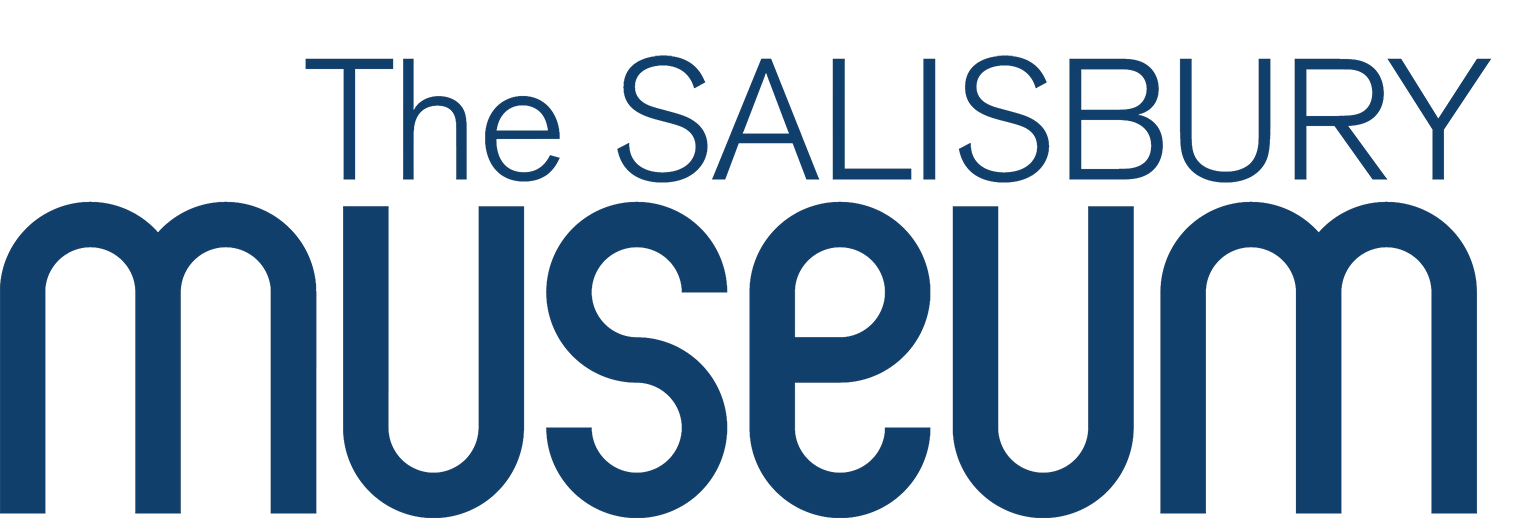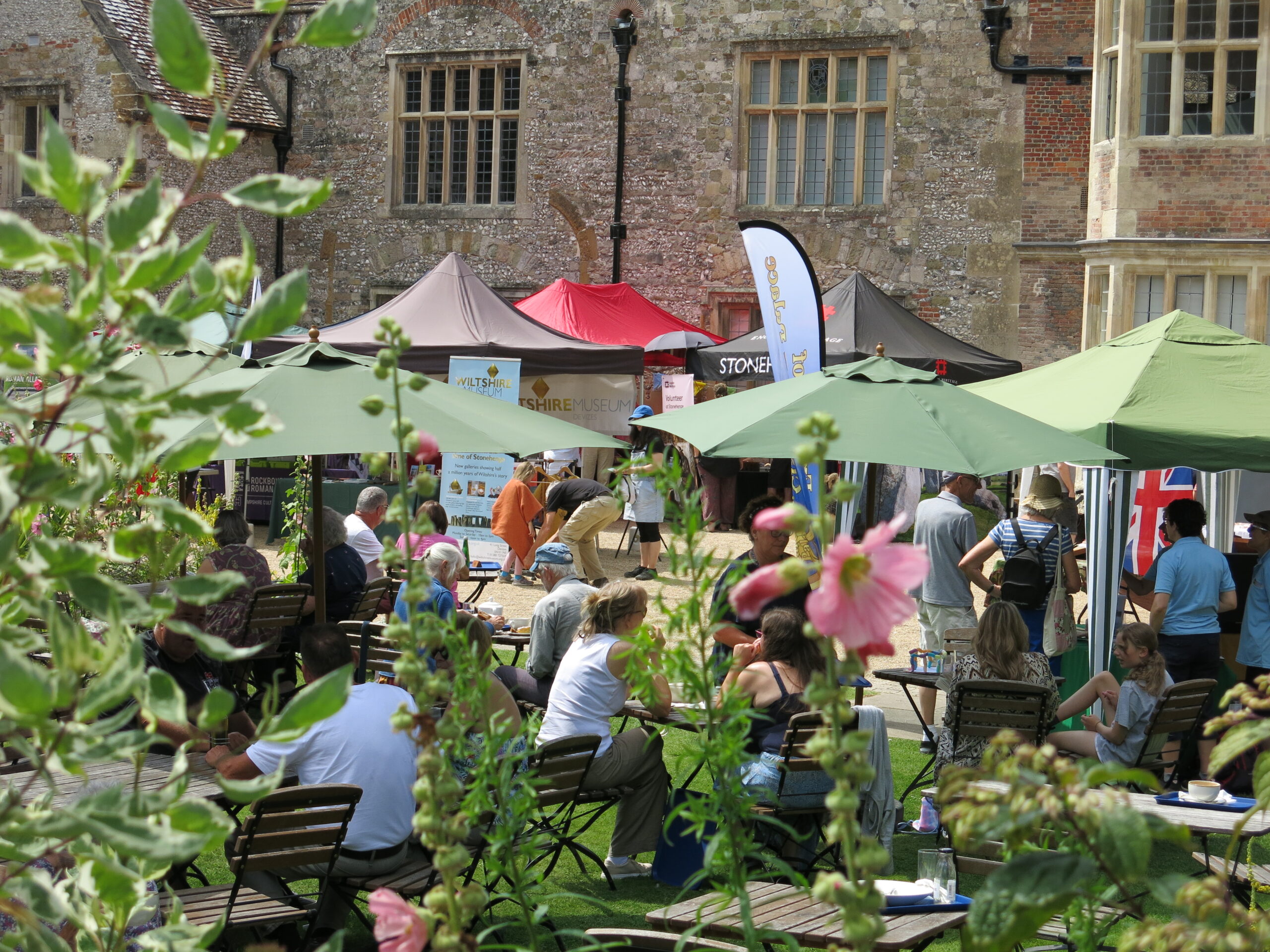New School Sessions
Where would you go if you could travel back through Salisbury’s history?
Once hundreds of years ago water flowed down the streets of this city. A Giant paraded whilst people cheered, monks prayed in their friary, disease sometimes spread, people fell in love and lived and died, and the streets changed with the ages. All through this the cathedral loomed, watching buildings fall and roads built, children growing up, going to its schools, giving back to the city that raised them. There was a place though that saved these stories from being lost, that collected the objects that held them, kept them safe and now they are ready and waiting. They want to show you the stories of their city. They live at The Salisbury Museum.
The opening of the new Devenish Bradshaw History of Salisbury galleries, Natural History and Ceramics galleries is the culmination of a number of years National Lottery funded work, to both create amazing new displays but also to put community at the heart of what we offer. This has included the development of our new learning offer, where staff have worked with teachers and children to research and create new ways of working with you, to enrich and support your classroom learning, with exciting school trips and continuing outreach work, stand-alone sessions and mini-projects. Post Covid, we wanted to focus on enrichment, cross-curricular work, as well as local history projects, building pride and aspiration as well as supporting curricular learning.
A local museum should support and belong to local people – you are the next chapter of this city’s rich and fascinating history – what stories will you discover and contribute?
What do the new galleries contain?
The new Salisbury galleries tell the story of the city and surrounding area from 1220 to the present day. Visitors are taken on a time-travelling adventure, starting with finds from our medieval waterways and Clarendon Palace, right up to Novichok and a dramatic concluding display of our beloved Salisbury Giant. The Natural History gallery also tells a local story, exploring our amazing local landscapes and habitats from grass downland to our rare chalk streams. Ideally suited to both STEM and creative learning, the gallery explores issues that really matter to young people today such as biodiversity and climate change. We also have an amazing new ceramics gallery, perfect for creative inspiration.
Why local history?
Local history is unique in its ability to bring history to life by locating it in places we know. Imagine a dramatic historical event not happening miles away in a place your students can’t picture, but on a street they might walkdown every day!
By enriching our knowledge of the places around us, of their stories and past lives, local history can also help build a sense of pride and belonging in our communities. Recent studies have shown how important this sense can be for aspiration building, confidence and greater wellbeing for young people. If you feel you are part of the story of where you live, then you feel more agency and ownership of your life within it. We want The Salisbury Museum to be a place where your students feel they belong, where they are part of its story going forward with real agency in their learning.
New sessions and projects to book:
EYFS-KS1:
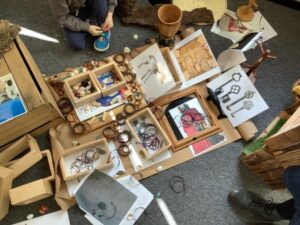
- Create your own museum inspired book – a creative mini project building story creating skills inspired by the characters in the museum, includes illustration workshop and a finished booklet to take home – one site visit plus outreach follow up. This could work for both the Salisbury and Natural History galleries.
- Our favourite things – this session looks at the objects that mean the most to us. Children get the chance to share a special belonging, look at what might be in a museum, create a display where these belongings live and a story about them. Available as outreach.
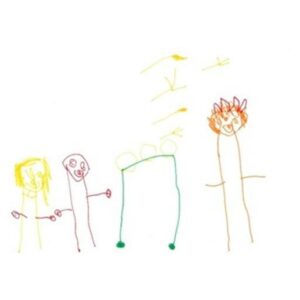
- Past and present, old and new – what makes something old? What do past present and future mean? By looking at old objects and comparing them to new ones, children explore these concepts. Story creating and memory sharing/what we are looking forward to, can also be used.
- Create your own imaginary wild garden – children learn about our local landscape and its creatures, before creating the own with art and story creating. Available as outreach or onsite with a visit to our Natural History gallery.
KS1-2:
Local history studies
We want your school to feel that the galleries are there as a resource for you to discover the stories of the place you call home. With this in mind we now have available to book an exciting new range of both stand-alone sessions and supported mini-projects, covering both the history curriculum in terms of local history studies, but also a wider cross curricular approach to your history learning.
- Option One: Immersive kick-starter day for enquiry-led local history projects:
Children will be invited to the museum to discover the amazing local stories the new Devenish Bradshaw History of Salisbury galleries hold. Starting with a gallery explore (utilising our new trails) the children will then have a more focused workshop experience, creating work inspired by what they have discovered.
The focus can be tailored in terms of the extent of it being child or specific agreed theme led.
The gallery explore will be followed by a creative session inspired by their discoveries. Children will each leave with their own miniature project book, a history explorer’s journal, full of their ideas to inspire further work back in school.
There is the option for teachers of an advance planning visit to discuss your class’s potential project. We are keen to give you the bespoke experience you need, to best inspire your students.

- Option two – longer local history supported project:
For a more in depth study the kick-starter day can be booked with a series of follow up outreach visits to further support your local history study. For more details please see our learning brochure.
Bookable sessions that work with local history studies:
- Lost and found – the story of Salisbury’s lost waterways
Did you know that water once flowed down the streets of Salisbury? This has been one of the best loved facts that young people discovered during our consultation. During this session children will learn about what Salisbury looked like during medieval times, up to Victorian changes when the waterways were filled in and over 1000 objects were found that had been lost or thrown away in the water. Children will get to see and handle objects from the collection before designing and creating a collage of their own drainage collection based on what they might lose today – what might an alien coming in the future find from our lives?
- The Time-Travelling Giant
Christopher, our beloved Salisbury Giant, has lived in the city for at least 500 years, witnessing its history and being present at key moments of community celebration and commemoration. Perfect for a local area through time study, this mini project will take students through key moments in Salisbury’s history that the Giant has been present at, from coronations and jubilees, to the Children’s Peace Pageant of 1919. Children will get a sense of the timeline of the city’s history, helping introduce ideas of chronology, as well as seeing real photos from our archive of past parades, from the 19th through to the 20th centuries. This mini project, when run as outreach, can take place over up to six sessions, culminating in a choice of creative outcomes showcasing the students design for their own pageant. Options include a collaborative art piece for your wall, drama and a booklet of creative writing including stories or a programme. Please feel free to contact us to discuss what would work best for you. What would you celebrate today?
- Pageant Giants
An additional Giant themed session, this looks at Christopher’s place in the wider European pageant giant tradition, introduces students to other giants, culminating in the creation of your own class pageant design for the city today.
- Clarendon Palace – the lives of medieval Kings and Queens
This session will introduce your students to Clarendon Palace and the key monarchs who visited there, King Henry II and Queen Eleanor of Aquitaine, King Henry III and Queen Eleanor of Provence. We will explore what the palace would have been like to visit, interior and garden design (including a chance to see real medieval decorated tiles), medieval pastimes and the changing landscape of what was once a huge Royal hunting forest. Children will have then have the chance to design their own medieval palace including mythical creatures to decorate the tiles.
- The Car
This session is based on Salisbury Museum’s largest artefact – the 1912 ‘Scout’ car, built in Salisbury, and now displayed in the museum for the first time. The session is designed as a hook into thinking about the history of transport, how transport has developed and where the future lies for humans getting around the planet. The session is cross curricular and can be focussed in many different ways, as requested by the teacher!
- WWI – How the Great War involved Everyone.
Objectives here are to provide a greater understanding of how war imposed itself on everyone, ranging from the soldiers in the trenches, to the community at home.
The session encourages an emotional response to WWI, adding extra dimension to the historic facts learnt in the classroom. A better understanding is also demonstrated of how historians use primary resources to build a picture of events in the past.
Resources for this session include a handling collection of everything familiar to a serving soldier, ranging from personal belongings, fighting equipment, diet and military ephemera. A collection of KS2 sized replica costumes for the roles which both men and women took in the war effort are a part of this session to encourage empathy and to bring a more personal response to the topic.
Other potential themes for local history studies:
All the above sessions and projects work well as part of your enquiry led local history studies and encourage a creative approach and are adaptable to your class’s needs. We want your students to feel empowered and enthusiastic about their new local area knowledge and our supportive approach is designed to help build confidence and aspiration – a sense of pride and belonging in community. We are always happy to discuss how to tailor the new galleries and this learning offer to support what you want to discover and create. With this in mind there are a number of additional ideas listed below which we can support you with and create bespoke projects and sessions.
- Women’s history – not just suffragettes! An in focus look at one or a selection of the fascinating women whose story is told in our local history galleries. This includes women in World War One, queens, scientists, teachers, writers and even witches!
- The children’s peace pageant of 1919.
- Health – themes covered in the galleries include everything from plague and cholera, to research into the common cold and Novichok.
- World war two and the secret spitfire factory
- The Swing Riots - a look at the rural impact of the industrial revolution
Natural History Sessions (available onsite and as outreach):
- Rewild the city
What would your city look like if it went back to nature? In this session children will get the chance to discover the animals and plants native to the area, explore ideas around biodiversity and rewilding and design their own future rewilded city. Mixing STEM learning, creative writing skills through world building and art, the outcome of this session will be a large-scale art piece of their rewilded Salisbury.
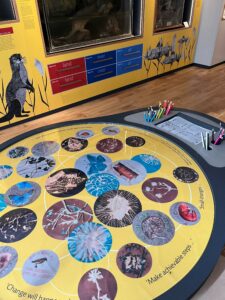
- A tale of our wild creatures – an animal’s point of view
This session has both a STEM and creative writing focus. Children will learn about their local wildlife past and present, from otters to butterflies, falcons to fish, and the issues it faces in today’s world due to climate change and biodiversity loss. They will then create characters that are these animals and create a piece of writing about them, their challenges and adventures, increasing empathy and understanding of our local natural world. How do birds see the world. What super-senses might you discover? What is it like to run as fast as a hare? How have writers in the past explored this? The outcome for this session is either an individual or group collaborative illustrated booklet to take home. This session can also be tailored around a particular habitat, such as our chalk streams or grass downlands.
For more information, an initial discussion or to book a session please contact Project Learning Officer Alice Maddicott alicemaddicott@salisburymuseum.org.uk
Download our history of Salisbury for primary schools learning brochure HERE.
KS3-KS5.
Not just the history curriculum – how can the museum support you as a creative learning partner?
As young people, museums can seem alienating spaces or somewhere only for those with an existing history interest, but we believe they can be so much more and offer something to everyone; that they can be a place of personal creative discovery as well as traditional learning. A particular focus of our outreach work since 2022 has been building our work with secondary schools and creatively thinking about how we work with you. Our development period has been collaborative and cross-curricular, with a real focus on the museum as creative resource. We have developed projects with Art and English departments, as well as looking at the history curriculum. We have also developed a number of enrichment projects and a programme of bookable talks, designed in collaboration and consultation with teachers and students. We are committed to long term support as well as one-off sessions, to really grow partnerships and meaningful engagement. Our staff are experts in local history and creative approaches to learning, so if there is a particular theme you are interested in, let us know!
Why local and natural history?
Our new programme is focused around the new Devenish Bradshaw History of Salisbury galleries, as well as our new Natural History and ceramics galleries. By enriching our knowledge of the places around us, of their stories and past lives, local history can help build a sense of pride and belonging in our communities. Recent studies have shown how important this sense can be for aspiration building, confidence and greater wellbeing for young people. If you feel you are part of the story of where you live, then you feel more agency and ownership of your life within it. We want The Salisbury Museum to also be a place where your students feel they belong, where they are part of its story going forward with real agency in their learning.
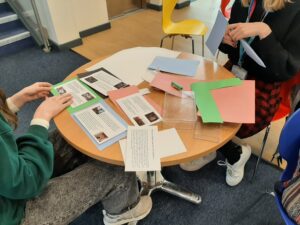
The new Salisbury galleries tell the story of the city and surrounding area from 1220 to the present day. The Natural History galleries also tell a local story, exploring our amazing local landscapes and habitats from grass downland to our rare chalk streams, through themes that really matter to young people today such as biodiversity and climate change. We also have an extensive ceramics gallery, newly curated to tell the story of ceramics from prehistory to the present day and great inspiration for creative projects.
What we can offer:
Research based creative practice – a supported art project
How are contemporary artists inspired by history and how do they use research in their art? What can museums offer to aid your creative practice, and can the creation of a museum be an artwork in itself?
Over the past two years we have worked with art teachers and students to develop and run as a pilot, a project exploring how we can use the museum and local history to inspire our work. The pilot ran twice as a term-long weekly project with year ten, culminating in a portfolio of work, assessable for their GCSE, however it is adaptable to KS3 and 5 as well. Museum and school staff collaborated and co-designed the project, adapting as it evolved with the students’ ideas. A member of the museum team, herself an artist and published writer, worked with a class for one lesson a week, with the project being continued in the other lessons. This is a project designed to be bespoke to best expand your students experience both of history and contemporary art, as well as working to build pride in community and a sense of belonging. With this in mind, the first stage is to contact us to arrange a free initial consultation meeting to discuss ideas and what we could offer.
Testimonial: “Working with Alice has given our students a unique opportunity to develop their understanding of their own environment. The project was led in an open and collaborative way which meant we have been able to meet the needs of our students and ensure we are delivering a dynamic and challenging curriculum. The project centered around Bemerton Heath and with the introduction of various artists and access to artefacts from the museum, this alongside Alice’s unwavering enthusiasm and excellent subject knowledge ensured our students had an amazing experience. They were able to interpret the work of artists and create personal responses using media they had not previously experimented with. This collaboration has been invaluable and Alice has been an amazing ambassador for how the museum can work successfully and collaboratively with schools. I am certainly looking forward to being able to work with Alice and the Salisbury Museum again”. – Art Teacher
Curate your life!
What does a curator do? How is an exhibition or a museum gallery created? Do we use curation skills in our life all the time without realising it?
This project ran as a weekly pilot as part of a KS5 enrichment group, but is adaptable to other age ranges. Students worked with museum staff to look at all aspects of curation, from museum displays, interpretation writing, design and themes to social media and how we curate our lives. This led to an exhibition curated by the students inspired by local history, their community and their lives in Salisbury today.
This course gives students a real insight into what it is like to work in a museum or gallery. They will learn new skills and ways of thinking, as well as engaging creatively with local history and their lives.
Available both as an enrichment course, or as an intensive one day enrichment session.
Testimonial: “ I found working with Alice very enjoyable, it encouraged a deeper interest in local history and engagement with the local community (specifically the museum) and enabled space for creativity while looking into serious topics. It helped me consider what I want to do with my career, as various different jobs linking to history, curation and many other topic areas were covered, as well as it being a genuinely fun yet still educational break from the more stressful side of college.” - Student
The Young Producers Lab Podcast!
Why not hear from some of the students we have worked with - below is a podcast by The Young Producers - a group of young people that have been meeting weekly at the museum, getting involved in curation and creative projects. Listen below:
Research and independent study support
Do your students need some support with their A-level Art independent study? We are here to support them, both with advice and research pointers as well as the museum being available for visits and booking behind the scenes appointments if there is something of interest in our stores that is not on display. This includes our large fashion and textile collection, as well as archaeological finds, art and much more. Our brand new Ceramics Gallery might also provide inspiration – telling the story of ceramics from pre-history to the modern day there are many amazing examples on display in our beautiful Tudor King’s Room, itself a design inspiration!
Creative writing workshops
Need inspiration for your creative writing? The museum collections and the local history stories they contain are rich inspiration. Our project learning officer is a published writer and has taught creative writing to young people for twenty years. Why not book a bespoke enrichment or English Language support session or project using real museum objects and history as the starting point? This is a bespoke offer, so please contact us to discuss your needs.
Talks:
Our staff are expert on a number of fascinating local takes on international history topics. Current talks available include ones on Local Women in World War One and Early Modern Witchcraft and the Salisbury Witch Trials. Other talks are in development, so do let us know if there is an area of particular interest to you.
For an initial discussion about how we can work with you please contact Project Learning Officer Alice Maddicott alicemaddicott@salisburymuseum.org.uk
For more information about what we are offering including additional themes in the new galleries please download our secondary age learning pack HERE.
We are also currently developing a number of projects with FE and HE colleges – these include working with media and game design courses. If you are interested in discussing potential collaborative projects please contact us.
